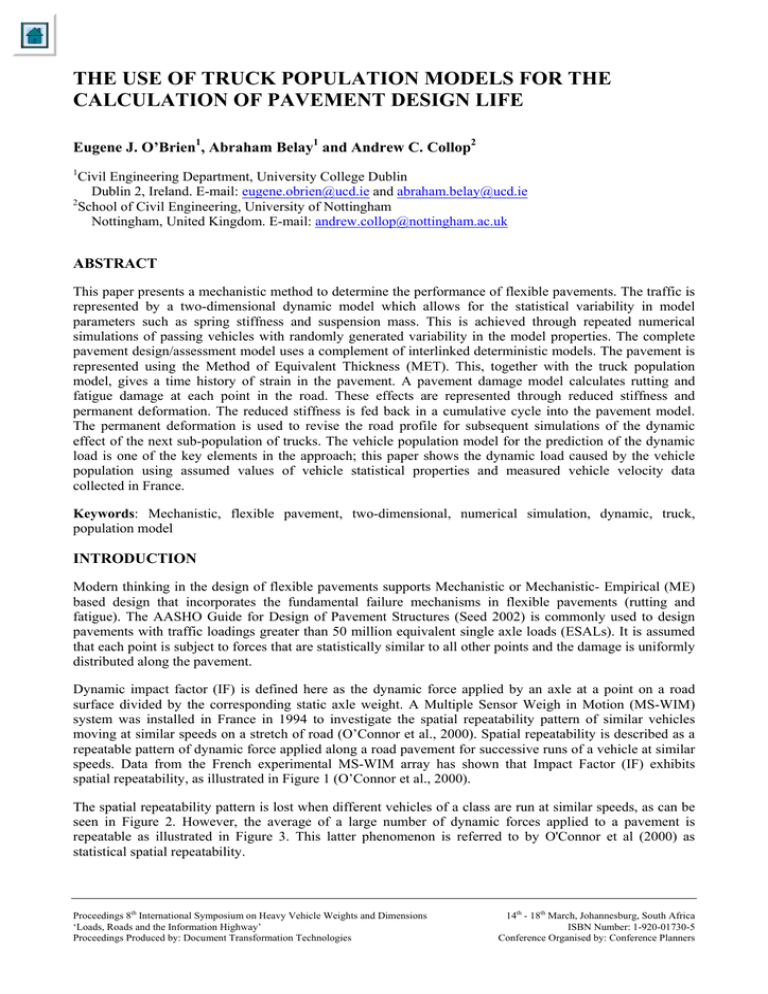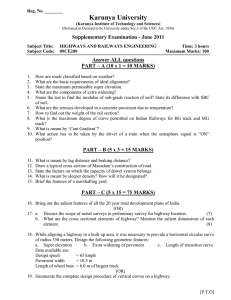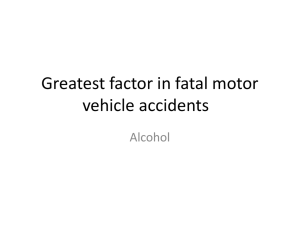THE USE OF TRUCK POPULATION MODELS FOR THE Eugene J. O’Brien
advertisement

THE USE OF TRUCK POPULATION MODELS FOR THE CALCULATION OF PAVEMENT DESIGN LIFE Eugene J. O’Brien1, Abraham Belay1 and Andrew C. Collop2 1 Civil Engineering Department, University College Dublin Dublin 2, Ireland. E-mail: eugene.obrien@ucd.ie and abraham.belay@ucd.ie 2 School of Civil Engineering, University of Nottingham Nottingham, United Kingdom. E-mail: andrew.collop@nottingham.ac.uk ABSTRACT This paper presents a mechanistic method to determine the performance of flexible pavements. The traffic is represented by a two-dimensional dynamic model which allows for the statistical variability in model parameters such as spring stiffness and suspension mass. This is achieved through repeated numerical simulations of passing vehicles with randomly generated variability in the model properties. The complete pavement design/assessment model uses a complement of interlinked deterministic models. The pavement is represented using the Method of Equivalent Thickness (MET). This, together with the truck population model, gives a time history of strain in the pavement. A pavement damage model calculates rutting and fatigue damage at each point in the road. These effects are represented through reduced stiffness and permanent deformation. The reduced stiffness is fed back in a cumulative cycle into the pavement model. The permanent deformation is used to revise the road profile for subsequent simulations of the dynamic effect of the next sub-population of trucks. The vehicle population model for the prediction of the dynamic load is one of the key elements in the approach; this paper shows the dynamic load caused by the vehicle population using assumed values of vehicle statistical properties and measured vehicle velocity data collected in France. Keywords: Mechanistic, flexible pavement, two-dimensional, numerical simulation, dynamic, truck, population model INTRODUCTION Modern thinking in the design of flexible pavements supports Mechanistic or Mechanistic- Empirical (ME) based design that incorporates the fundamental failure mechanisms in flexible pavements (rutting and fatigue). The AASHO Guide for Design of Pavement Structures (Seed 2002) is commonly used to design pavements with traffic loadings greater than 50 million equivalent single axle loads (ESALs). It is assumed that each point is subject to forces that are statistically similar to all other points and the damage is uniformly distributed along the pavement. Dynamic impact factor (IF) is defined here as the dynamic force applied by an axle at a point on a road surface divided by the corresponding static axle weight. A Multiple Sensor Weigh in Motion (MS-WIM) system was installed in France in 1994 to investigate the spatial repeatability pattern of similar vehicles moving at similar speeds on a stretch of road (O’Connor et al., 2000). Spatial repeatability is described as a repeatable pattern of dynamic force applied along a road pavement for successive runs of a vehicle at similar speeds. Data from the French experimental MS-WIM array has shown that Impact Factor (IF) exhibits spatial repeatability, as illustrated in Figure 1 (O’Connor et al., 2000). The spatial repeatability pattern is lost when different vehicles of a class are run at similar speeds, as can be seen in Figure 2. However, the average of a large number of dynamic forces applied to a pavement is repeatable as illustrated in Figure 3. This latter phenomenon is referred to by O'Connor et al (2000) as statistical spatial repeatability. Proceedings 8th International Symposium on Heavy Vehicle Weights and Dimensions ‘Loads, Roads and the Information Highway’ Proceedings Produced by: Document Transformation Technologies 14th - 18th March, Johannesburg, South Africa ISBN Number: 1-920-01730-5 Conference Organised by: Conference Planners Figure 1. Spatial repeatability of impact factor – repeated runs of same truck on same pavement at similar speeds (from O’Connor et al, 2000). Figure 2. Loss of spatial repeatability of Impact Factor for different trucks with similar velocities (s=steel suspension, a = air suspension) (from O’Connor et al, 2000). O'Connor et al. (2000) showed that, on average, dynamic forces are not equally distributed along the pavement profile. As a result, it is not reasonable to expect a uniform probability of failure. Mechanistic or mechanistic-empirical approaches to the design of flexible pavements can allow for this distribution of dynamic force, thereby resulting in a considerably more realistic representation of the forces applied to particular points. Theoretical modelling and the availability of higher quality data from MS-WIM systems has facilitated the development of ME design procedures. In order to design a flexible pavement to successfully withstand traffic loading for its design life, the failure mechanisms must be adequately understood. The two main structural failure mechanisms for flexible pavements are permanent deformation (rutting) and fatigue damage. Permanent deformation is the result of an accumulation of plastic deformation in the various pavement layers by the action of the repeated wheel loadings. The response of a pavement material to repeated wheel loading can generally be divided into two distinct forms; recoverable and irrecoverable deformations. It is the accumulation of the irrecoverable deformations over millions of load applications that results in a wheel truck rut. Depending on the materials used and the type of the construction, rutting may result from permanent deformations in all the layers or the surface layer alone. Figure 3. Statistical spatial repeatability of Impact Factor – Mean of measured Gross Weights on pavement for 1 day, all trucks of a type (from O’Connor et al, 2000). Fatigue cracking has been defined as the phenomenon of fracture under repeated or fluctuating stress with a maximum value generally less than the tensile strength of the material. Fatigue cracking can initiate anywhere in the bound material but is usually found at the base or the surface of the asphaltic layers. Failure conditions have been reached when there is evidence of extensive cracking in the wheel path. In this paper a vehicle population model was developed using a two-dimensional vehicle with dynamic properties obtained from the literature (Zhang et al, 2001) and French Weigh-In-Motion (WIM) data. The result of the simulated dynamic impact factor obtained by the Author has shown spatial repeatability, which is consistent with the findings of others (O’Connor et al. 2000, Cole et al. 1992, Collop 1996, Cebon 1985, Ervin 1983, Hahn 1985). OVERALL DESIGN PROCEDURE The overall framework for the calculation of pavement life is based on the procedure developed by Collop and Cebon (1995) and is illustrated in Figure 4. It can be seen from this figure that the procedure can be divided into four main areas: • Dynamic vehicle simulation; • Pavement primary response calculation; • Pavement damage calculation; • Damage feedback mechanism. The inputs to the model are: (i) the details of the pavement being simulated (layer thicknesses, mix specifications etc.); (ii) the time increment to be used in the simulation; (iii) the rate of traffic loading and (iv) the climatic conditions. Vehicle simulation Environment Tyre forces static Force Influence function Distance Time Road response calculation Strain Road strain at each point Time Log N Material properties Surface rutting fed back into vehicle model Fatigue damage fed back into primary response model Strain Road model Road damage model Log e Damage Theoretical road damage Distance along road Figure 4. Long-term pavement performance methodology (from Collop and Cebon, 1995). From this initial specification, a length of pavement surface profile is generated and divided into many equally spaced sub-sections (to accommodate variations in layer thicknesses). A time domain vehicle simulation is used to generate dynamic tyre forces for vehicles as a function of distance. A set of primary response ‘influence functions’ is generated, for each pavement sub-section and each mode of damage using the Method of Equivalent Thicknesses (MET) (Ullidtz 1987). The modes of damage that are included in the model are structural rutting and fatigue damage to the asphaltic layers. These primary response influence functions are combined with the dynamic tyre forces, to give primary pavement response time histories at a large number of equally spaced discrete points along the pavement. The primary responses are combined with the appropriate pavement damage models and the number of load applications, to predict damage (rutting and fatigue damage) as a function of distance along the pavement for the current time increment. An updated surface profile is then generated by subtracting the calculated rutting in the wheel path from the initial profile used for that time increment. This mechanism accounts for the effects of changing surface roughness on the pattern of statistical spatial repeatability and hence the pattern of mean dynamic tyre forces. The calculated fatigue damage is used to reduce the elastic modulus of the asphaltic material for each sub-section. This mechanism reflects the effects of cumulative fatigue damage on the primary responses and hence subsequent pavement damage. The above process is then repeated for the next time increment, and so on, until the pavement has reached the end of its serviceable life. TRUCK POPULATION MODEL A half car vehicle dynamic model was developed using the equations described by Fryba (1999), Figure 5. Typical parameters for spring stiffness, masses and damping, K1, M1, C1, etc., were taken from Zhang et al. (2001) – see Table 1. Velocity and distance between the axles was taken from the statistical analysis of Weigh in Motion data collected from highway A1 near Russons in France (Grave, 2001) – see Table 1. The latter data was collected for five successive days from a three lane dual carriageway from the left-most and right-most lanes. Only vehicles weighing 3.5 tonnes and above were registered as trucks and used to calculate dynamic impact forces. Monte Carlo simulations of the half car model were run using a wide range of model parameters. These parameters were assumed to be Normally distributed. Random numbers were generated (Press et al. 1992) and the appropriate Cumulative Distribution Function applied (Ang and Tang 1975) to generate a representative population of model parameters. The IF was calculated at intervals of 0.01 m along the pavement length. The road model was defined based on the power spectral density function according to ISO standards (Wong 1993). Figure 5. 2-Dimensional, 4 degree of freedom truck model parameters (from Fryba, 1999). Table 1. Parameters of truck model (Zhang et al, 2001 and Grave, 2001). Parameter K1 (N/m) K2 (N/m) K3 (N/m) K4 (N/m) M1 (kg) M2 (kg) M3 (KN) C1 (Ns/m) C2 (Ns/m) D (m) Velocity (m/s) Mean value 6 1 x 10 1 x 106 5 x 105 5 x 105 0.75 x 103 0.75 x 103 200 2 x 104 2 x 104 4.9 23.43 Variance 0.03 0.03 0.03 0.03 0.03 0.03 0.07 0.03 0.03 1.0 4.20 K1 and K2 are tire springs of rear and front axle, C1 and C2 suspension dampers, K3 and K4 suspension springs, M3 is the body mass of the vehicle, M1 and M2 are axle loads and D is the distance between the axles, D/2 it the distance between body mass centre to the axles. RESULTS Figure 6 shows the simulated impact forces (IF) for Axle 1. Unlike Figure 2, there is strong spatial repeatability for individual runs of similar trucks at similar but different speeds. For successive runs, the vehicle parameters and velocity were changed while the road profile was the same. It is felt by the authors that the spatial repeatability in the model is the result of using an identical road profile for each run. In field trials, changes in truck transverse position result in a significant variation in the road profile for each run. This has not been allowed for in this two dimensional study. Figure 6. Individual runs to show the spatial repeatability when a variety of vehicle parameters and speeds are assumed. Figure 7. Dynamic Impact factor for a pavement length of 50 m. Figure 7 presents the average Axle 1 impact forces from 1000 simulations. There is a very strong pattern of statistical spatial repeatability. The very strong spatial repeatability is felt by the authors to again to be the result of using an identical road profile in all runs. DISCUSSION AND CONCLUSIONS The results from the truck population model show a far stronger degree of spatial and statistical spatial repeatability than has been observed in field measurements. This may be as a result of taking an excessively small standard deviation in some of the model parameters. However, the evidence points to the assumed road surface profile being the dominant "parameter" influencing spatial repeatability. Clearly, small transverse variations in truck position result in different road profiles being experienced by the vehicle model. However, while different, adjacent road profiles will be similar to one another and the degree to which they are similar has a strong influence on the degree to which spatial repeatability will be present. Work is currently under way to simulate a two-dimensional "carpet" of road surface levels that is representative of typical transverse level variations found in field measurements. Vehicle transverse positions within the lane will be generated using Monte Carlo simulation and the appropriate road profile extracted from the carpet for each vehicle run. It is anticipated that this approach will lead to a much reduced spatial and statistical spatial repeatability in Figures 6 and 7. It is proposed to use impact factor data from a Multiple-Sensor Weigh-in-Motion site to calibrate the truck population model. Once calibrated, the Mechanistic design approach will provide a much improved understanding of the nature of pavement deterioration a given pavement type and the spatial variation in this process. The work described in this paper demonstrates an approach to the modelling of pavement deterioration which represents a major advance in conventional methodologies. While there is clearly much that remains to be done, this approach seems likely to result in a major contribution understanding and ultimately to an improvement in the accuracy of pavement service life calculations. ACKNOWLEDGMENTS This work is financed under the Pilot Transport Research Programme administered by the Higher Education Authority of Ireland. REFERENCES 1. Ang, A.H.S. and Tang, W.H. 1975, Probabilistic Concepts in Engineering Planning and Design, John Wiley and Sons. 2. Cebon, D. 1985, An investigation of the dynamic interaction between wheeled vehicles and road Surfaces, PhD Thesis, University of Cambridge.1985. 3. Cole, D.J., Cebon, D. 1992, ‘Spatial repeatability of dynamic tyre forces generated by heavy Vehicles’ Proc. Instn Mech. Engrs, Part D, 1992,206(D1), pp17-27. 4. Collop, A.C., Cebon, D. and Cole, D.J. 1996, ‘Effects of Spatial repeatability on long- term flexible pavement performance’ IMechE Journal of Engineering Science Vo. 210, pp 97-110, 1996 5. Collop, A.C and Cebon, D. 1995, ‘A model of whole-life flexible pavement performance.’ IMechE Journal of Engineering Science Vol. 209, pp 389-407, 1995. 6. Ervin, R.D. 1983, Influence of truck size and weight variables on the stability and control properties of heavy trucks, Technical Report UMTRI-83-10/2, University of Michigan. Transportation Research Institute. 7. Fryba, L. 1999, Vibration of Solids and Structures under Moving Loads, Thomas Telford Ltd, London. 8. Grave,S. 2001, Modelling of Site-Specific Traffic Loading on Short to Medium Span Bridges, PhD Thesis, Dept. of Civil Engineering, Trinity College Dublin, Ireland. 9. Hahn, W.D. 1985, Effects of commercial vehicle design on road stress - vehicle research results, Institut fur Kruftfahrwesen, Universitat Hannover,1985 (Translated by TRRL as WP/V&ED/87/38). 10. O’Connor,T., E.J.O’Brian and B.Jacob, B . 2000, ‘An Experimental Investigation of Spatial Repeatability’. Heavy Vehicles Systems, International Journal of Vehicle Design, Vol. 7,No.1,2000, pp.64-81. 11. Press, W.H., Flannery, B.P. Teukolsky, S.A. and Vetterling, W.T. 1992, ‘Numerical Recipes in C’ The art of Scientific computing, Cambridge University Press, New York. 12. Seeds, S.B. 2002., Flexible Pavement Design Summary of the state of the Art A2B03:Committee on Flexible Pavement Design, Nichols Consulting Engineers, Reno, Nevada, TBR. 13. Ullidtz, P. 1987, ‘Pavement Analysis’ In Developments in Civil Engineering, Vol. 19, Elsevier Science Publishers BV, Amsterdam, The Netherlands (1987). 14. Wong, J.Y. 1993, Theory of Ground Vehicles, John Wiley & Sons.(1993). 15. Zhang Qi-Lin, Vrouwenvelder A. and Wardenier J. 2001., ‘ Dynamic amplification factors and EUDL of bridges under random traffic flows’, Engineering structures 23 (2001), 663-672.





